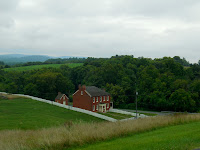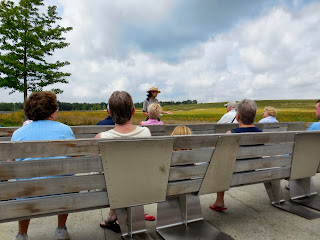 You'll probably be glad to hear that I've had enough battlefields for awhile, so this won't be a battlefield post. There will definitely be history--and that's the point of Harpers Ferry National Historical Park. (Actually there were battles there during the Civil War, but there's plenty of other stuff to do around town.)
You'll probably be glad to hear that I've had enough battlefields for awhile, so this won't be a battlefield post. There will definitely be history--and that's the point of Harpers Ferry National Historical Park. (Actually there were battles there during the Civil War, but there's plenty of other stuff to do around town.)We took the shuttle bus from the Visitors Center--really more of a kiosk--to Lower Town (which is in the park), then to the Info Center at the Master Armorer's House to get an idea of what's there and where to go. Kind of a weird setup, but it works.
Lots of history in Harpers Ferry. Seems like everyone stopped there at one time or another: George Washington, Thomas Jefferson, Meriwether Lewis, Abraham Lincoln, John Brown. There are bridges all over the place near "The Point" where the Shenandoah flows into the Potomac: a couple RR bridges (one's for the B&O RR from my Monopoly game) with this pedestrian bridge alongside one of them.
Here's the remains of an old wooden bridge destroyed 9 times by armies and floods during the Civil War, and more pilings of another one. I do like bridges.
The Park Service realize people have different interests, so they set up 6 different themes to follow around the park. Most of the old buildings are now mini-museums.
Industry: The town became an industrial center when the US Armory and Arsenal was built there. Like the one in Springfield, MA, they made and stored guns for the military. It was blown up by the Federals during the Civil War, so the Confederates wouldn't get the guns. But the equipment to make them was saved, and they got moved south. This is where part of the Armory stood.
Meriweather Lewis stocked up on rifles and ammunition at the Armory before he and William Clark left on their NW journey. He has his own museum.
Natural Heritage: The Shenandoah flows into the Potomac at Harpers Ferry and then through the water gap, past the kayakers and the highway bridge a mile away.
.JPG)
Natural Heritage: The Shenandoah flows into the Potomac at Harpers Ferry and then through the water gap, past the kayakers and the highway bridge a mile away.
.JPG)
Transportation: Railroads, canal, ferries--the trains still come through the tunnel. The C&O Canal towpath is now part of the Appalachian Trail, where hikers and bikes share the road. You can see bits of all of it here.
John Brown: The radical abolitionist's raid to seize 100,000 guns at the arsenal was a plan to free slaves. The Armory fire station where he holed up has been renamed as "John Brown's Fort". (This was one of the themes I was interested in.) Brown's raid failed and he was captured and hanged, but it sure was a catalyst for the Civil War. Here's something cool: Union soldiers came up with a catchy marching song called "John Brown's Body" (which I remember from grade school). Later when Julia Ward Howe wrote "The Battle Hymn of the Republic", she put her words to that tune.
 Civil War: The Civil War was terrible for Harpers Ferry. The town changed hands eight times during the war. Two days before the Battle of Antietam, Gen. Robert E. Lee sent Stonewall Jackson to capture the town to protect his supply route. Over 12,000 Federal troops surrendered. This is what Bolivar Heights Battlefield looks like now. I took a total of SIX pictures here.
Civil War: The Civil War was terrible for Harpers Ferry. The town changed hands eight times during the war. Two days before the Battle of Antietam, Gen. Robert E. Lee sent Stonewall Jackson to capture the town to protect his supply route. Over 12,000 Federal troops surrendered. This is what Bolivar Heights Battlefield looks like now. I took a total of SIX pictures here.
African American History: History here mirrors that of the country--from slavery to a place of refuge for runaway slaves to one of the first schools for black students and then on to the Niagara Movement. The old Storer College is now an NPS Training Center.
Hikers go down these steps off High Street (or up, depending on whether they're heading northbound or southbound).
The Appalachian Trail Conservancy is headquartered up on the hill. Hikers can stop in to use computers in the Hiker's Lounge, or get all the information imaginable about the AT from the friendliest volunteers ever!I'm pretty sure we'll never walk the whole trail, but it's kind of cool running across it all over the place.
Click the link for more pictures of Harpers Ferry NHP


.JPG)


















.JPG)

.jpg)
.JPG)





.JPG)

.JPG)







.JPG)

.JPG)












.JPG)




